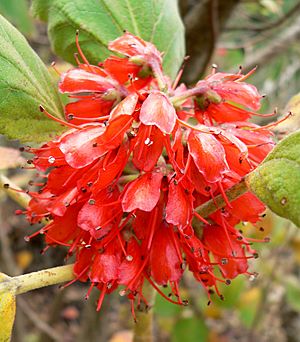Woolly bottlebrush facts for kids
Quick facts for kids Woolly bottlebrush |
|
|---|---|
 |
|
| Scientific classification | |
| Genus: |
Greyia
|
| Species: |
radlkoferi
|
Beaufortia eriocephala, also called the woolly bottlebrush or woolly beaufortia, is a special plant found only in the south-west part of Western Australia. It belongs to the myrtle family, which is a big group of plants called Myrtaceae. This plant is unique because it has fuzzy, red flowers and young leaves that are a bit hairy. Its older leaves are very thin, less than 1 millimeter wide!
Contents
What it Looks Like
Beaufortia eriocephala is a small, bushy plant. It usually grows to be about 0.5 meters (about 1.6 feet) tall and 0.4 meters (about 1.3 feet) wide.
Its leaves grow in pairs, one across from the other. They are long and thin, like tiny spears, measuring about 5 to 10 millimeters long and less than 1 millimeter wide. When the leaves are young, they feel a bit hairy, but as they get older, they become smooth.
Flowers and Fruits
The flowers of the woolly bottlebrush grow in round clusters at the ends of the branches. Even after the flowers bloom, the branches keep growing!
Each flower has 5 sepals (small leaf-like parts that protect the bud) and 5 petals (the colorful parts of the flower). It also has 5 groups of stamens, which are the parts that make pollen. Each group has 3 to 5 stamens. The part of the stamens that are joined together are deep red and fuzzy, about 2.5 to 3.5 millimeters long. The free parts of the stamens are red to purple and are a bit longer, about 3 to 4.5 millimeters.
You can see these beautiful flowers from October to December. After the flowers fade, they turn into woody capsules, which are like small, hard seed pods. These capsules are about 8.5 to 10 millimeters long.
Plant Name and History
The woolly bottlebrush was first officially described in 1905 by an Australian plant expert named William Vincent Fitzgerald. He wrote about it in a science journal.
The plant's scientific name, eriocephala, comes from two old Ancient Greek words. "Erion" means "wool," and "kephalē" means "head." So, "eriocephala" basically means "woolly head," which perfectly describes its fuzzy flower clusters!
Where it Grows
You can find Beaufortia eriocephala in several natural areas of Western Australia. These areas include the Avon Wheatbelt, Geraldton Sandplains, Jarrah Forest, and Swan Coastal Plain.
This plant likes to grow on slopes in sandy soil. This soil often comes from a type of rock called laterite, which is rich in iron and aluminum.
Looking After the Plant
The Western Australian Government's Department of Parks and Wildlife keeps an eye on plants like the woolly bottlebrush. They have classified Beaufortia eriocephala as "Priority Three."
This means that we don't know a lot about this plant, and it's only found in a few places. However, it's not in immediate danger of disappearing. It's important to keep track of these plants to make sure they stay safe for the future.
See also
 In Spanish: Greyia radlkoferi para niños
In Spanish: Greyia radlkoferi para niños

